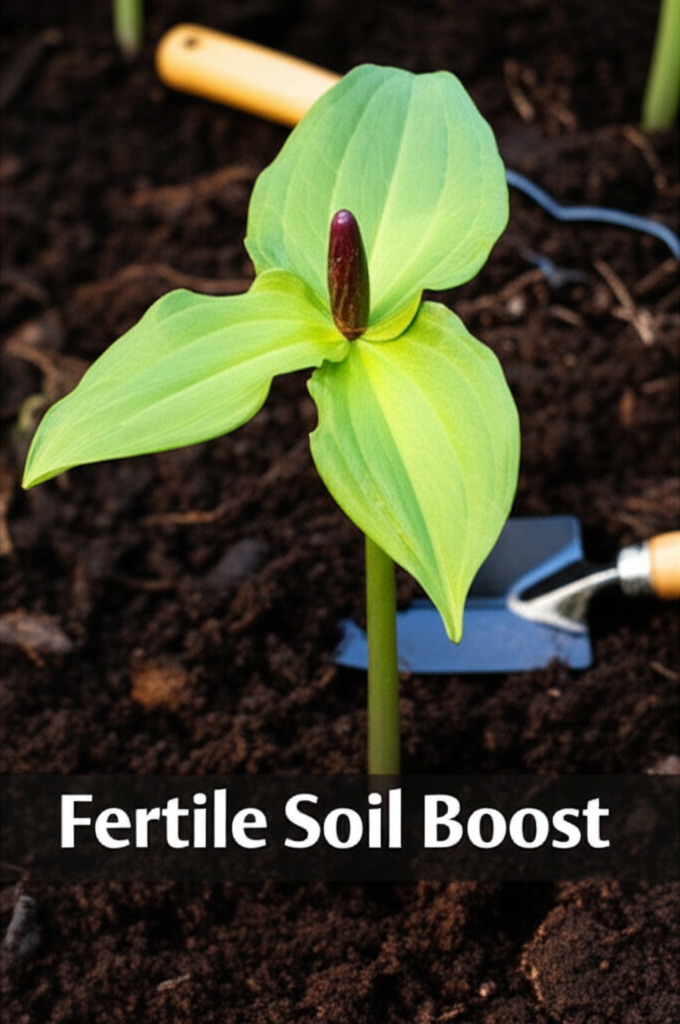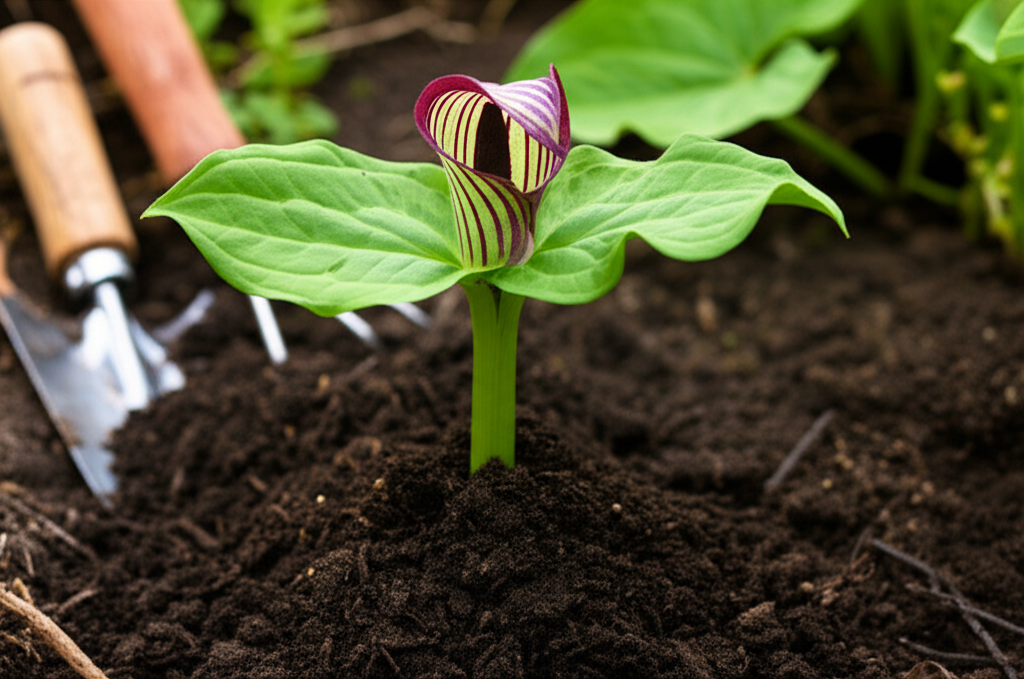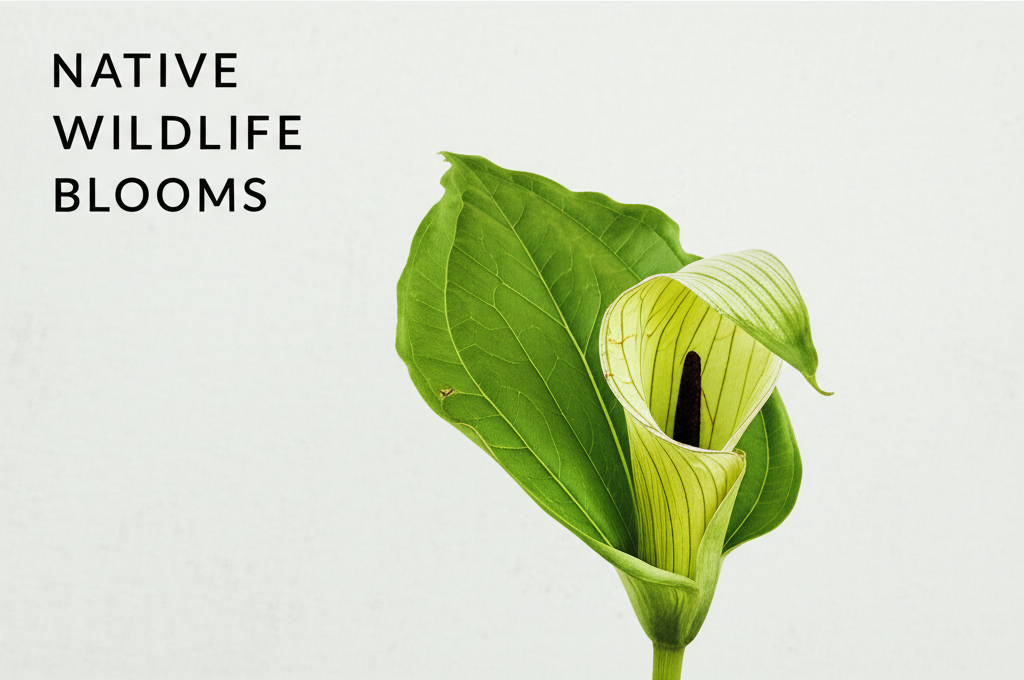Unearthing the Mysteries of Jack-in-the-Pulpit Soil Needs
The Jack-in-the-Pulpit (Arisaema triphyllum), a native woodland wildflower, is as fascinating in its botanical structure as it is demanding in its environmental preferences. Renowned for its distinctive spathe and spadix, often resembling a preacher in a pulpit, this plant thrives in specific conditions that are crucial for its successful cultivation and, importantly, its vibrant display. While often found in its natural habitat, bringing this woodland jewel into your garden requires a keen understanding of its soil fertility requirements. This article delves into the methods of improving soil fertility to foster robust growth and abundant blooming in your Jack-in-the-Pulpit plants.
Understanding the Jack-in-the-Pulpit’s Natural Habitat
To effectively improve soil fertility, we must first understand where Jack-in-the-Pulpit naturally flourishes. These plants are typically found in:
- Damp, shaded woodland areas.
- Rich, organic-rich soils.
- Areas with good moisture retention but also adequate drainage.
- The understory of deciduous forests, where leaf litter is abundant.
These observations highlight a key principle: Jack-in-the-Pulpit prefers soils that mimic a healthy forest floor – moist, fertile, and teeming with life. Mimicking these conditions in a garden setting is the primary goal of soil fertility improvement.
The Foundation of Fertility: Organic Matter is King

The most impactful way to enhance soil fertility for Jack-in-the-Pulpit is through the liberal incorporation of organic matter. Organic matter is the cornerstone of healthy soil, providing nutrients, improving soil structure, enhancing water retention, and fostering beneficial microbial activity.
Compost: The Gardener’s Gold
Well-rotted compost is arguably the single most effective amendment for Jack-in-the-Pulpit. It acts as a slow-release fertilizer, delivering a broad spectrum of nutrients essential for plant growth.
- Nutrient Richness: Compost provides nitrogen, phosphorus, potassium, and a host of micronutrients that fuel the development of healthy leaves, stems, and the iconic flower spathe.
- Improved Soil Structure: It loosens compacted soils, allowing for better root penetration and aeration, while also improving the water-holding capacity of sandy soils.
- Microbial Support: Compost is a living medium, teeming with beneficial bacteria, fungi, and other microorganisms that break down organic material, making nutrients available to the plant and suppressing soilborne diseases.
Application: Aim to incorporate a generous layer of finished compost, at least 2-4 inches, into the top 6-8 inches of your planting bed before establishing your Jack-in-the-Pulpit. Top-dressing annually with compost is also highly beneficial.
Leaf Mold: Nature’s Perfect Mulch
Leaf mold, the result of decomposed deciduous leaves, is another exceptional amendment. It is particularly valuable for its ability to improve soil structure and water retention without adding excessive nutrients, which can sometimes be detrimental if overdone.
- Excellent Soil Conditioner: Leaf mold creates a friable soil texture, promoting aeration and drainage.
- Water Retention: It significantly enhances the soil’s capacity to hold moisture, crucial for keeping the Jack-in-the-Pulpit consistently hydrated.
- Slow Nutrient Release: While not as nutrient-dense as compost, leaf mold releases nutrients gradually as it continues to decompose in the soil.
Preparation: Collect fallen leaves in autumn and either shred them before piling or simply pile them. Keep the pile moist and allow them to decompose for one to two years.
Aged Manure: A Nutrient Powerhouse (with Caution)
Well-aged animal manure can be a potent source of nutrients, but it must be composted thoroughly. Fresh manure can burn plant roots and introduce pathogens.
- High Nutrient Content: Aged manure, especially from herbivores like cows and horses, is rich in nitrogen and other essential plant foods.
- Improved Soil Fertility: When properly composted, it adds valuable organic matter and nutrients to the soil.
Caution: Always ensure manure is “aged” or composted for at least 6-12 months. Incorporate it sparingly, mixing it well with existing soil to avoid root burn.
pH Matters: Finding the Sweet Spot for Jack-in-the-Pulpit
Jack-in-the-Pulpit prefers slightly acidic to neutral soil pH, ideally between 5.5 and 7.0. Soil pH affects nutrient availability, with certain nutrients becoming locked up in the soil at extreme pH levels.
Testing Your Soil’s pH
Before making any amendments, it’s wise to test your soil’s pH. Simple DIY kits are available at garden centers, or you can send samples to a local cooperative extension office for professional analysis.
Adjusting Soil pH
- To Lower pH (Make it more acidic): Incorporate elemental sulfur or acidic organic matter like peat moss or pine needles.
- To Raise pH (Make it more alkaline): Add lime, such as ground limestone or dolomitic lime.
Frequency of Adjustment: pH adjustments are typically not needed annually. Make them based on soil test results and observe the plant’s response. Over-correction can be as detrimental as an incorrect pH level.
Enhancing Drainage: Preventing Root Rot
While Jack-in-the-Pulpit appreciates consistent moisture, it cannot tolerate waterlogged conditions, which can lead to corm rot. Improving drainage is paramount, especially in areas with heavy clay soils.
Incorporating Aeration Amendments
- Coarse Sand: While not ideal in large quantities on its own, coarse sand mixed with organic matter can improve drainage in clay soils.
- Perlite/Vermiculite: These lightweight, porous materials improve aeration and drainage without altering the soil’s pH.
- Gravel/Small Stones: For severely compacted or clay-heavy areas, a shallow layer of gravel at the bottom of the planting hole or bed can assist with initial drainage, though large quantities are not recommended as they can create a perched water table.
Methods: Mix these amendments thoroughly into the planting area, aiming for a significant improvement in soil porosity.
Nutrient Supplementation: When and How
While organic matter is the primary source of nutrients, occasional supplementation may be beneficial, particularly in established gardens where nutrient reserves may have been depleted.
Slow-Release Fertilizers
For a balanced and sustained release of nutrients, opt for slow-release organic fertilizers. These are formulated to break down gradually, providing a steady supply of food to the plant.
- Organic Balanced Fertilizers: Look for fertilizers with a balanced N-P-K ratio (e.g., 5-5-5 or 10-10-10) derived from organic sources like bone meal, blood meal, or feather meal.
- Timing: Apply in early spring as new growth emerges and again in mid-summer if the plant shows signs of stress or reduced vigor.
Dosage: Always follow the manufacturer’s instructions carefully to avoid over-fertilization.
Specific Nutrient Needs
- Nitrogen: Crucial for foliage development. Provided by compost, aged manure, and some organic fertilizers.
- Phosphorus: Important for root development and flowering. Bone meal is a good source.
- Potassium: Aids in overall plant health and disease resistance. Wood ash (in moderation) or kelp meal can provide potassium.
Key Facts and Comparison of Soil Improvement Methods
Understanding the benefits and drawbacks of various soil fertility enhancement methods is crucial for making informed decisions.
| Method | Primary Benefit | Secondary Benefits | Considerations |
|---|---|---|---|
| Compost | Broad-spectrum nutrient supply, improved soil structure, water retention, microbial activity | pH buffering | Requires good quality, well-rotted compost. Can be time-consuming to produce. |
| Leaf Mold | Excellent soil structure improvement, superior water retention | Slow nutrient release, pH buffering | Takes 1-2 years to produce. Less nutrient-dense than compost. |
| Aged Manure | High nutrient content (especially nitrogen) | Adds organic matter | MUST be well-aged/composted to prevent root burn and pathogens. Use in moderation. |
| Elemental Sulfur | Lowers soil pH (acidifies) | None | Use cautiously. Takes time to work. Over-application can harm soil life. |
| Lime | Raises soil pH (alkalinizes) | Adds calcium and magnesium | Use cautiously. Takes time to work. Over-application can lead to nutrient lockout. |
| Coarse Sand | Improves drainage in heavy soils | Increases aeration | Must be mixed with organic matter. Too much can create drainage issues if not combined with organic matter. |
| Perlite/Vermiculite | Improves aeration and drainage | Lightweight | Can be expensive. Does not add nutrients. |
Step-by-Step Guide to Improving Jack-in-the-Pulpit Soil
A systematic approach ensures that your soil is optimized for these unique woodland plants.
- Assess Current Soil Conditions: Examine your soil’s texture, drainage, and moisture retention. Perform a pH test.
- Gather Amendments: Source high-quality compost, leaf mold, or other organic materials. Purchase pH adjusters if necessary.
- Prepare the Planting Area: Clear the area of weeds and debris.
- Incorporate Organic Matter: Spread a 2-4 inch layer of compost and/or leaf mold over the planting bed.
- Till or Dig In: Gently work the organic matter into the top 6-8 inches of soil using a garden fork or tiller. Aim for a loose, friable texture.
- Adjust pH (If Needed): Add sulfur or lime according to soil test recommendations, incorporating it thoroughly.
- Improve Drainage (If Needed): For heavy clay soils, mix in perlite or coarse sand with the organic matter.
- Planting: Position your Jack-in-the-Pulpit corms at the correct depth (typically 3-4 inches, pointed end up) in the prepared soil.
- Mulch: Apply a 1-2 inch layer of organic mulch (leaf litter, shredded bark) around the base of the plants, keeping it a few inches away from the stems. This helps retain moisture, suppress weeds, and further enriches the soil as it decomposes.
- Water Thoroughly: Water the newly planted Jack-in-the-Pulpits gently but deeply.
Pros and Cons of Different Fertility Strategies
Choosing the right strategy depends on your specific situation and goals.
| Strategy | Pros | Cons |
|---|---|---|
| Heavy reliance on compost | Excellent all-around soil improvement, slow-release nutrients, promotes beneficial soil biology. | Can be costly if purchasing large quantities; requires effort to produce if making your own. |
| Emphasis on leaf mold | Superior soil structure and water retention, low nutrient addition (avoids over-fertilization). | Takes time to create; less nutrient-dense than compost. |
| Using aged manure | Potent source of nitrogen and other nutrients. | Risk of root burn if not fully composted; potential for introducing unwanted weed seeds or pathogens. |
| Frequent synthetic fertilizer use | Quick nutrient availability, easy to apply. | Can lead to nutrient imbalances, salt buildup, damage to soil microbes, and potential for runoff pollution. Not ideal for woodland plants. |
| Ignoring pH | No extra effort or cost. | Nutrient deficiencies or toxicities can occur, hindering plant growth and health. |
Ongoing Care: Maintaining Soil Fertility
Soil fertility is not a one-time fix but an ongoing process.
- Annual Top-Dressing: Apply a layer of compost or leaf mold around your Jack-in-the-Pulpits each spring. This replenishes nutrients and organic matter.
- Mulch Renewal: Top up your mulch layer as needed to maintain its insulating and moisture-retaining properties.
- Observe Your Plants: Yellowing leaves, stunted growth, or poor flowering can indicate nutrient deficiencies or imbalances. Adjust your fertility practices accordingly.
- Avoid Compaction: Try to minimize walking on or working the soil when it is wet, as this can lead to compaction and reduce aeration.
By understanding and implementing these soil fertility improvement methods, you can create the ideal conditions for your Jack-in-the-Pulpit to thrive, rewarding you with their unique beauty and fascinating botanical display year after year. Cultivating the cauldron of the Jack-in-the-Pulpit with rich, well-amended soil is the key to unlocking its full potential.


